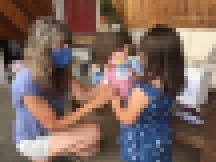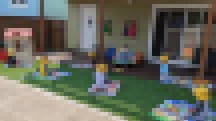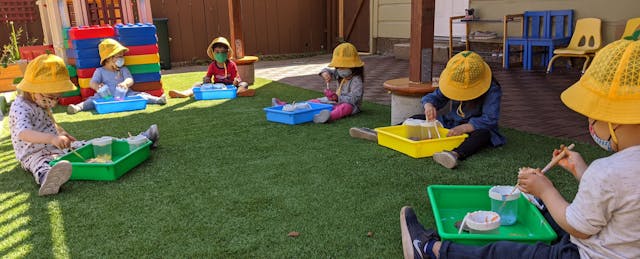“Circle time” conjures an image of children sitting close together, cross-legged, on a brightly colored rug as a teacher guides them through the day’s routines and lessons. The kids might be asked to describe what the weather is like, verbalize how they’re feeling or practice a new letter in the alphabet. And most likely, they’ll do it all while singing, clapping and laughing.
This seemingly harmless practice, like so many others, has been complicated by the pandemic. A group of children packed tightly into one space? That defies social distancing guidelines. Sharing a carpet? Only if the fabric can be wiped down and disinfected. Singing and laughing for a sustained period of time? That’s risky, as these actions produce large volumes of respiratory droplets.
Under new safety protocols, early childhood educators have had to get creative about how they provide instruction and care. Some elements of child care have been phased out, at least for now, while new practices have been introduced in their place. A few things, such as playing together and physical contact between children, have been virtually impossible to eliminate. But nearly everything else—from circle time and dramatic play to sensory activities and socialization—has had to adjust in one way or another.
New Routines and Renovations
Child care professionals are used to cleaning up spills, sticky substances and all sorts of germs in their workplaces, so many already had daily cleaning regimens. But with COVID-19, these cleaning and sanitation routines now happen more frequently.
Before the pandemic, Pyrena Hui, a home-based child care provider in San Francisco, and her assistant teacher would disinfect surfaces once all the children had been picked up for the day. Now, they clean high-touch surfaces (such as door handles and faucets) three times a day, disinfect toys as they are used and do a full wipe down of the whole space twice a day. “It’s a lot of work,” Hui admits.
Another change is the ongoing search to secure personal protective equipment (PPE).
Both Hui and Chris Nelson, a home-based child care provider in Troy, Vt., have had trouble finding the cleaning supplies and PPE they need at times—first when the pandemic began, in the spring, and again now that cases have skyrocketed across the country.
For Nelson, who lives on a 100-acre farm in a rural area about two hours from Burlington, the search for supplies can be burdensome. She has to drive a half-hour to get to the nearest store that sells cleaning products. Sometimes, they’re completely sold out of soap, paper towels and Lysol. And earlier in the pandemic, even when those products were in stock, the store was limiting all customers to one of each item—a major issue for someone who works with kids every day.
“We were doing a lot more traveling, going every three days, like, ‘Maybe Lysol will be back this week,’” she recalls.
When Nelson reopened her child care program in June, she worried about kids bringing the coronavirus into her home and infecting her family members (one of whom is diabetic and therefore at higher risk of complications from COVID-19). So she invested $4,000 into renovating a standalone garage on the property where she could teach the kids. She added flooring, cabinets and a kitchen to make it a decent alternative to her house.
“This is the only job I can think of where you’d bring COVID into your house,” Nelson says. “We bring kids into the house. They’re in our living space.”
She figured that until the public had a better understanding of how the virus was spread, and until the children in her program were used to wearing masks and keeping their distance, activities were best held outside or in an altogether different space.

“They come as infants,” she says of the children she serves. “They’re used to my home being their home. They think they can touch anything. I didn’t want to create a ‘no’ environment. I didn’t want to bring them back after three months to, ‘You can’t do this,’ and ‘Don’t touch this.’ I wanted it to be where we were outside, having fun.”
Now that the kids are accustomed to wearing their masks and know to give their friends some space—and with the weather often too cold for outdoor learning—Nelson has brought the kids back inside her house like they were before COVID-19, at least until she outfits the garage with heating.

In the Boston area, Alice Nakibuuka and her fellow educators at Bright Horizons at Charlestown, a child care center serving infants, toddlers and preschoolers, had to learn the new safety and sanitation protocols quickly. After closing the program in Charlestown to their existing families from March to July, the center reopened as an emergency child care program for essential workers in the interim, serving the children of grocery store workers and doctors at Massachusetts General Hospital a mile down the road.
Now, the safety procedures are second nature for staff, says Nakibuuka, who teaches in the toddler classroom. She describes how, if kids are coloring at one table and a child drops his marker, she “has a keen eye on grabbing that marker and spraying it down before another child touches it.”
The children have also adjusted.
“The more we’ve done, the more they’ve gotten used to the routine of it,” Nakibuuka says. “If we pull an activity out, they know to wait a few seconds for Miss Alice to spray it down and make sure it’s clean.”
Nelson has had a similar experience, noting that her toddlers are especially cooperative during the developmental stage they’re in.
“My 3-year-olds come in the door at 7 a.m., and I never remind them—they always have their mask on, take it off to eat, grab some hand sanitizer as they go by the wall,” she says. “Kids that age are the easiest because they’re used to things changing and being able to do more as they get older.”
Adapting Fun Activities
Dramatic play is a critical element of learning and development for young children, intended to spur their imagination and creativity. This type of play often involves costumes and acting out characters, careers or important figures.
Educators say this is one of the least pandemic-friendly activities they were doing before COVID-19, since it involves soft surfaces and fabrics that can’t easily be sprayed and wiped clean. As a result, they’ve put the dress-up clothes away for now.
Hui, the San Francisco provider, occasionally makes exceptions because her kids enjoy dramatic play so much. She says she pulls out the costumes about once a month and makes sure each child only wears one uniform the whole time. When they’re done, she runs it all through the washing machine.
Stuffed animals and puppets are also out, as the soft material is especially good at trapping germs. Nakibuuka tried to keep a penguin puppet in rotation in her classroom but eventually felt it created too much potential exposure to the virus. For a replacement, she and her assistant teacher printed out pictures of animals and laminated them, making it easy to wipe down between each child’s use.
Sensory activities, such as water play, sand boxes and using shared manipulatives like counting cubes, also presented some risk, as they often involve several children sharing materials or even having their hands in a shared space at one time.
Kristal Salcido, a pre-K lead teacher at Happy Day Preschool in Caldwell, Idaho, used to fill a big sensory table with water for her children to play with. Since that’s not an option anymore, she opted for individualized sensory boxes, made out of plastic bins and filled with items that can be sanitized daily—glass rocks, plastic fish and a fishing pole, blocks and more. After cleaning the objects, she rotates them through each child’s box to allow for some variety. Salcido has also made individual sensory trays and filled them with shaving cream for children to play with.
“It’s harder,” she says. “I definitely had to get more creative. With this age group, you have to change things up and change toys out to keep them interested.”

Nakibuuka says she struggled with phasing out the sensory activities and sees it as an ongoing challenge at her center.
“At any age, sensory activities [encourage children to] grab and explore. They explore and manipulate sand or snow or even water in different ways, which ... helps them be engaged and focused,” she says, adding that the recent winter storm in Boston would’ve created an excellent opportunity for her toddlers to play with snow. “That we can’t bring that into the classroom has definitely taken a toll.”
One alternative Nakibuuka has come up with is a smell test. She bottled cinnamon, pine cones, sugar and orange peels for the children to sniff and discuss. “They were so excited to press and see what it smells like,” she says, laughing at the memory. “That engaged them for quite some time.” Another substitute she has come up with is sensory bags. In August she filled quart-sized Ziploc bags with different paints for children to “squish and see the colors mix.”
Circle time looks different now, too. Nakibuuka and her assistant teacher split up their eight children into two groups of four. Nakibuuka keeps her four occupied at a table in one part of the room while the assistant teacher does circle time with the other four, and then they switch.
Hui, who has the benefit of milder California weather this time of year, has been holding circle time outside as much as possible. Kids still sit in a circle, she says, but it’s a distanced one, and they’re all seated on their own picnic mats. In this arrangement, they are able to sing and read stories as they would inside in any other year.

The Hardest Part of the Job
For Nelson, the provider in Vermont, the most difficult adjustment has been the lack of physical connection between her and the kids.
“Affection has changed some,” she says. “You’re high-fiving instead of giving a hug. We don’t hold hands anymore when we go for a walk. Emotionally, that’s different. It’s just nice to give a kid a hug when they want a hug, to hold a hand when you go for a walk. The closeness is definitely different. I’ll be happy when that’s gone. Some kids really need it.”
Others note that it has proven nearly impossible to keep young children from touching one another and playing together.
“We’re trying as best as we can,” Nakibuuka says. “Unfortunately, that’s something we cannot avoid. You know, they love their friends. That’s something we never wanted to discourage. We ask them to give their friends space as much as possible and make sure they wash their hands as soon as they come in … because the second we turn around to grab something, they’re going to hug each other.”


